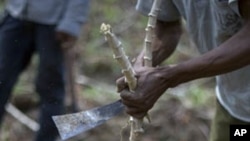The United Nations says a new disease destroying cassava crops across East Africa could turn into an epidemic.
The Food and Agriculcture Organization (FAO) says a new variant of Cassava Brown Streak Disease (CBSD) is spreading throughout the Great Lakes region of East Africa. The countries most affected are the Democratic Republic of Congo, Uganda, Burundi and Rwanda.
FAO Regional Emergency Officer Jan Helsen warns of extreme consequences to the region if the spread of the disease is not stopped.
“Let's say if nothing happens, if there is no continued support either technical, breeding or community-based or sanitization and, or institutional then the risk is very high -- the chance, no, the risk that we'll have an epidemic is very real and the potential impact of food security on millions of people," Helsen said.
The disease, he said, has infected up to 30 percent of crops in Rwanda and Burundi and up to 80 percent in eastern Uganda.
Cassava is more than just a meal to much of East Africa.
The FAO says the cassava plant provides up to one-third of the daily calorie intake for people in those countries where the disease is most prevalent. It is also a relatively cheap source of nutrition for the urban poor.
At the same time, cassava has increasingly become an important export. The International Food Policy Research Institute estimates that world cassava production will reach 279 million metric tons by 2020 - about 60 percent of which will come from Africa.
Helsen with the FAO, says the agency is reaching out to regional partners, existing agricultural institutions and local communities to stop CBSD. He says education is a crucial tool.
“Farmers have to be made aware of good agricultural practices," he said. "This is the community based side of sanitation. If indeed they see that they can recognize symptoms on the leaves and say 'look, this is a diseased plant, you have to take it out.'”
One of the major obstacles for stopping the spread of CBSD is that the disease has different symptoms in different places.
Dai Peters, Project Director of the Great Lakes Cassava Initiative with Catholic Relief Services, says sometimes a totally healthy looking plant will turn out to be diseased, while a plant that looks diseased may actually be healthy.
“So that's why it's really difficult," Peters said. "Because you could see it in the leaves. You could see it in the stems, you could see it in the roots. But none of them is full proof. They are all difficult to be 100 percent accurate.”
Typically, to overcome a disease like CBSD, farmers could turn to another strain of cassava that is not susceptible to the disease, said Peters. So far, no such variant has been found.
And while the disease poses enough of a threat to food security on its own, it is made much worse in combination with other agricultural infections in the area.
One of the most serious is known as banana wilt, a virus that has destroyed entire banana plantations in the same areas impacted by CBSD.








